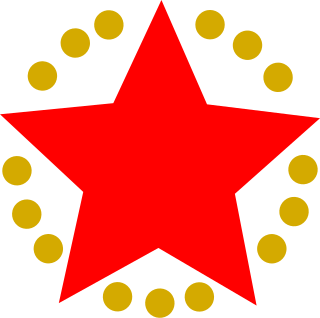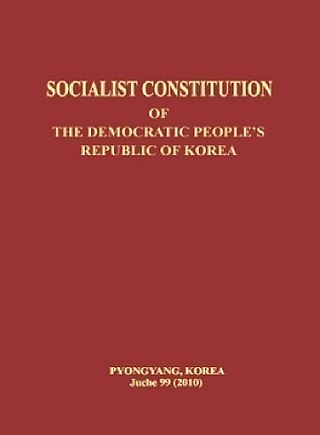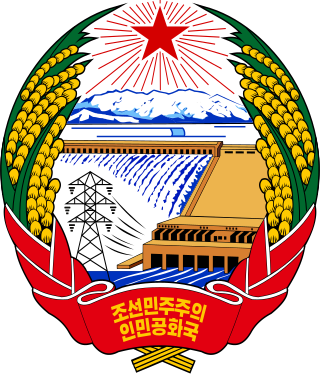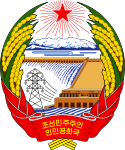
The president of the Socialist Republic of Vietnam is the head of state of Vietnam, elected by the Vietnam National Assembly from delegates of the National Assembly. Since Vietnam is a single-party state, the president is generally considered to hold the second highest position in the political system, formally after the general secretary of the Communist Party of Vietnam. In addition, the president appoints the head of government, the prime minister. As head of state, the President represents Vietnam both domestically and internationally, and maintains the regular and coordinated operation and stability of the national government and safeguards the independence and territorial integrity of the country.

The Supreme People's Assembly is the legislature of North Korea. It is ostensibly the highest organ of state power and the only branch of government in North Korea, with all state organs subservient to it under the principle of unified power. However, in practice it is widely considered to be a rubber stamp legislature which exists to approve decisions made by the ruling party as a formality, and which has little to no real power of its own.

The political system of the Soviet Union took place in a federal single-party soviet socialist republic framework which was characterized by the superior role of the Communist Party of the Soviet Union (CPSU), the only party permitted by the Constitution.

The premier of the Cabinet of the Democratic People's Republic of Korea, commonly called the premier of North Korea, is the head of government of North Korea and leader of the Cabinet.

Choe Yong-gon was the Supreme Commander of the Korean People's Army from 1948 to 1950, North Korean defence minister from 1948 to 1957, and the Chairman of the Standing Committee of the Supreme People's Assembly of the Democratic People's Republic of Korea from 1957 to 1972.

The Prime Minister of the Lao People's Democratic Republic, formerly the chairman of the Council of Government of the Lao People's Democratic Republic, is the head of government of Laos. The highest position in the government, they direct the country's executive branch. The prime minister is accountable to the president, the National Assembly and the country's only legal party: the Lao People's Revolutionary Party (LPRP). The current prime minister is Sonexay Siphandone, who was elected in 2022.

The Socialist Constitution of the Democratic People's Republic of Korea is the constitution of North Korea. It was approved by the 6th Supreme People's Assembly at its first session on 27 December 1972, and has been amended and supplemented in 1998, 2009, 2012, 2013, 2016, 2019 (twice), and in 2023. It replaced the country's first constitution which was approved in 1948.

In the North Korean government, the Cabinet is the administrative and executive body. The North Korean government consists of three branches: administrative, legislative, and judicial. However, they are not independent of each other, but all branches are under the exclusive political leadership of the Workers' Party of Korea (WPK).

The eternal leaders of North Korea are mentions of deceased leaders of North Korea. The phrase was mentioned in a line of the preamble to the Constitution, as amended on 30 June 2016, and in subsequent revisions.

The President of the State Affairs Commission of the Democratic People's Republic of Korea, alternatively styled "President of State Affairs" in official translations, is the supreme leader and head of state of North Korea. The president chairs the State Affairs Commission (SAC), which is the highest leadership institution in North Korea, and serves as the commander-in-chief of the North Korean armed forces.

The National Defence Commission of the Democratic People's Republic of Korea (NDC) was the highest state institution for military and national defence leadership in North Korea, which also served as the highest governing institution of the country from 1998 until 2016 when it was replaced by the State Affairs Commission.

Yang Hyong-sop was a North Korean politician who served as Chairman of the Standing Committee of the Supreme People's Assembly and Chairman of the Supreme People's Assembly from 1983 to 1998. He subsequently served as Vice President of the Presidium of the SPA from 1998 to 2019.

The Cabinet of Democratic People's Republic of Korea or North Korea (Naegak) is, according to the Constitution of North Korea, the administrative and executive body and a general state-management organ in the Government of North Korea. The Cabinet's principal newspaper is Minju Choson.

Upon its liberation in 1945 and subsequent foundation in 1948, North Korea adopted national symbols distinct from the national symbols of South Korea. The traditional flag of Korea, the Taegukgi, and the symbol Taeguk, were swapped for socialist symbols.

The State Affairs Commission of the Democratic People's Republic of Korea (SAC) is constitutionally the supreme political authority of North Korea. The State Affairs Commission was created by 2016 amendments to the North Korean Constitution to replace the previously military-dominated National Defence Commission.

The 11th Supreme People's Assembly of North Korea was in session from 2003 until 2009. It consisted of 687 deputies, and held six sessions.

The Chairman of the Supreme People's Assembly is the presiding officer of the Supreme People's Assembly, the legislature of North Korea.

The president of the Democratic People's Republic of Korea was the head of state of North Korea from 1972 to 1998. The position was only occupied by Kim Il Sung from 1972 until his death in 1994. Aside from being president, Kim was also the General Secretary of the Workers' Party of Korea, Chairman of the National Defence Commission and Supreme Commander of the Korean People's Army.

The vice chairman of the Standing Committee of the Supreme People's Assembly is one of the members that form the Standing Committee of the Supreme People's Assembly. The vice chairman of the SPA Standing Committee is elected by the Supreme People's Assembly alongside the SPA Standing Committee's chairman, secretary general and members. From 1972 until 1998, the vice chairman of the SPA Standing Committee was concurrently the vice chairman of the Supreme People's Assembly.






















